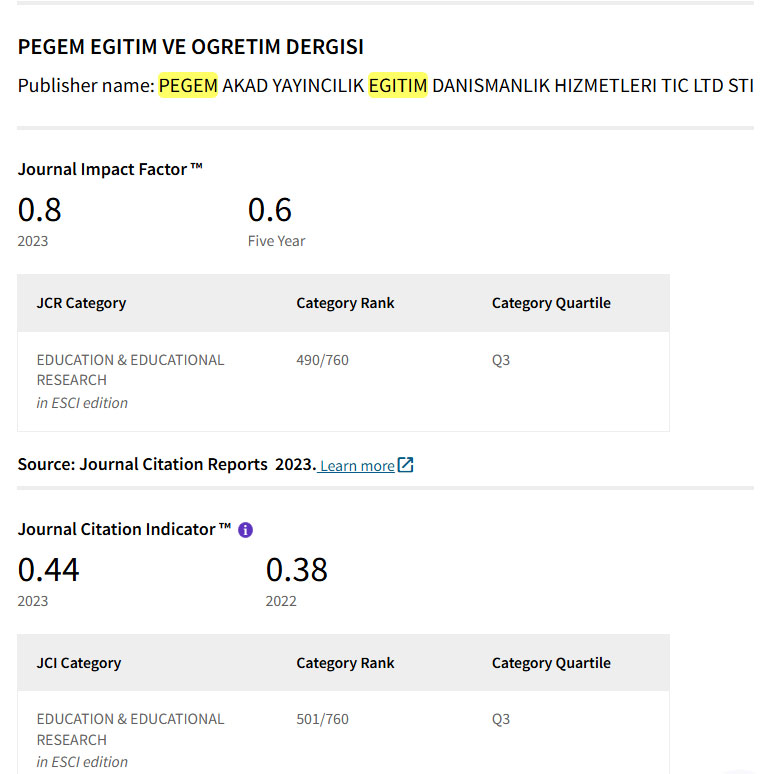The online publishing strategies in improving the higher education institution ranking: A case study of PGRI University of Yogyakarta
DOI:
https://doi.org/10.47750/pegegog.12.01.19Keywords:
online publishing, higher education, ranking, Scopus, Google Scholar, Web of ScienceAbstract
Online publishing is an important factor in determining a university’s ranking internationally. In formulating an effective strategy, academics need to understand the systems and criteria that are taken into account to determine the position of higher education institutions. This study was conducted to examine the understanding of PGRI University of Yogyakarta (UPY) lecturers toward the online publishing platform and the university ranking system as a measurement to identify their awareness of this field. This study used a quantitative method through a questionnaire involving 30 respondents from UPY lecturers. This study is analyzed by using descriptive analysis. The results of the study showed that the mean score of the awareness on online publishing platforms and the level of understanding of the respondents’ university ranking system was at a high level. In conclusion, the findings of the study showed the knowledge and understanding of UPY lecturers on the online publishing system are good.
Downloads
References
Ale Ebrahim, N., Salehi, H., Embi, M. A., Habibi, F., Gholizadeh, H., Motahar, S. M., & Ordi, A. (2013). Effective strategies for increasing citation frequency. International Education Studies, 6(11), 93-99.
Azman, M. N. A., Majid, T. A. & Ahamad, M. S. S. (2014). Strategi Penerbitan atas Talian dalam Meningkat Penarafan Universiti: Kes USM. Bulletin of, 15-19.
Elsevier. (2021). Content Coverage. https://www.elsevier.com/solutions/scopus/how-scopus-works/content?dgcid=RN_AGCM_Sourced_300005030 (access 1 December 2021).
Goolamally, N., & Ahmad, J. (2014). Attributes of School Leaders Towards Achieving Sustainable Leadership: A Factor Analysis. Journal of Education and Learning, 3(1), 122-133.
Hazelkorn, E., & Gibson, A. (2017). Global science, national research, and the question of university rankings. Palgrave Communications, 3(1), 1-11.
Harzing, A. W. K., & Van der Wal, R. (2008). Google Scholar as a new source for citation analysis. Ethics in science and environmental politics, 8(1), 61-73.
Huang, M. H. (2011). A comparison of three major academic rankings for world universities: From a research evaluation perspective. Journal of Library & Information Studies, 9(1), 1-25.
Khabsa, M., & Giles, C. L. (2014) The Number of Scholarly Documents on the Public Web. PLoS ONE 9(5): e93949.
Leontitsis, A., & Pagge, J. (2007). A simulation approach on Cron- bach’s alpha statistical significance, Mathematics and Computers in Simulation 73(5): 336–340.
Patton, M. Q. (1990). Qualitative evaluation and research methods. SAGE Publications, inc.
Pulikowski, A., & Matysek, A. (2021). Searching for LIS scholarly publications: A comparison of search results from Google, Google Scholar, EDS, and LISA. The Journal of Academic Librarianship, 47(5), 102417.
Publons. (2021). https://publons.com/about/home/ (access 1 December 2021)
QS. (2021). University Ranking Region Indonesia. https://www.topuniversities.com/university-rankings/world-university-rankings/2022 (access 1 December 2021)
Rahardja, U., Harahap, E. P., & Dewi, S. R. (2019). The strategy of enhancing article citation and H-index on SINTA to improve tertiary reputation. TELKOMNIKA, 17(2), 683-692.
Rozman, I., & Marhl, M. (2008). Improving the Quality of Universities by World‐University‐Ranking: A Case Study of the University of Maribor. Higher education in Europe, 33(2-3), 317-329.
ResearchGate. (2021). https://www.researchgate.net/ (access 1 December 2021)
Sadlak, J. (2006). Validity of university ranking and its ascending impact on higher education in Europe. Bridges, 12(12), 13-27.
Sidek, M. N. (2002). Reka bentuk penyelidikan: Falsafah, teori dan praktis. Serdang: Penerbit Universiti Putra Malaysia.
Sinta. (2021). Affiliations. https://sinta.kemdikbud.go.id/affiliations (access 1 December 2021)
Webometrics. (2021). Second edition of 2021: Web data collected during July 2021 (the 18th year!). https://www.webometrics.info/en/current_edition (access 1 December 2021)
Webometrics Indonesia. (2021). Asia Region: Indonesia. https://www.webometrics.info/en/Asia/Indonesia%20?page=1
Wu, J. (2013). Geographical knowledge diffusion and spatial diversity citation rank. Scientometrics, 94(1), 181-201. http://dx.doi.org/10.1007/s11192-012-0715-8
Zhang, C. T. (2013). The h’-index, effectively improving the h-index based on the citation distribution. PloS one, 8(4), e59912.
Downloads
Published
How to Cite
Issue
Section
License
Copyright (c) 2021 Pegem Journal of Education and Instruction

This work is licensed under a Creative Commons Attribution-NonCommercial 4.0 International License.
Attribution — You must give appropriate credit, provide a link to the license, and indicate if changes were made. You may do so in any reasonable manner, but not in any way that suggests the licensor endorses you or your use.
NonCommercial — You may not use the material for commercial purposes.
No additional restrictions — You may not apply legal terms or technological measures that legally restrict others from doing anything the license permits.




